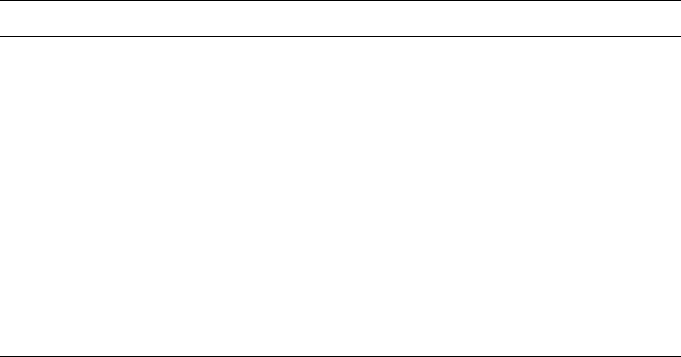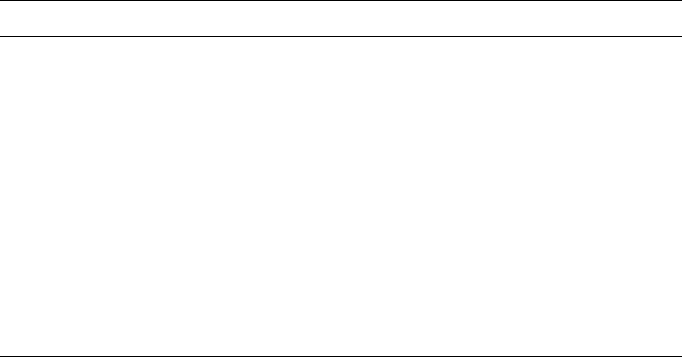Van Harmelen F., Lifschitz V., Porter B. Handbook of Knowledge Representation
Подождите немного. Документ загружается.


672 17. Event Calculus
Table 17.1. Original event calculus (OEC) predicates and functions (e, e
1
,e
2
= event occurrences,
f, f
1
,f
2
= fluents, p = time period)
Predicate/function Meaning
Holds(p) p holds
Start(p, e) e starts p
End(p, e) e ends p
Initiates(e, f ) e initiates f
Terminates(e, f ) e terminates f
e
1
<e
2
e
1
precedes e
2
Broken(e
1
,f,e
2
)fis broken between e
1
and e
2
Incompatible(f
1
,f
2
)f
1
and f
2
are incompatible
After(e, f ) time period after e in which f holds
Before(e, f ) time period before e in which f holds
In this chapter, we discuss several versions of the event calculus, the use of circum-
scription in the event calculus, methods of knowledge representation using the event
calculus, automated event calculus reasoning, and applications of the event calculus.
We use languages of classical many-sorted predicate logic with equality.
1
17.2 Versions of the Event Calculus
The event calculus has evolved considerably from its original version. In this section,
we trace the development of the event calculus and present its important versions.
17.2.1 Original Event Calculus (OEC)
The original event calculus (OEC) was introduced in 1986 by Kowalski and Sergot
[45]. OEC has sorts for event occurrences, fluents, and time periods. The predicates
and functions of the original event calculus are shown in Table 17.1. The axioms of
the original event calculus are as follows.
OEC1. Initiates(e, f ) ≡ Holds(After(e, f ))
2
.
OEC2. Terminates(e, f ) ≡ Holds(Before(e, f )).
OEC3. Start(After(e, f ), e).
OEC4. End(Before(e, f ), e).
OEC5. After(e
1
,f)= Before(e
2
,f)⊃ Start(Before(e
2
,f),e
1
).
OEC6. After(e
1
,f)= Before(e
2
,f)⊃ End(After(e
1
,f),e
2
).
1
We do not treat modal logic versions of the event calculus [9].
2
Kowalski and Sergot [45] use implication (⊃)inOEC1andOEC2.Sadri[87, p. 134] points out that
bi-implication ( ≡) was intended by Kowalski and Sergot but not used in order to prevent looping when
running the axioms in Prolog.
E.T. Mueller 673
OEC7. Holds(After(e
1
,f)) ∧ Holds(Before(e
2
,f)) ∧ e
1
<e
2
∧¬Broken(e
1
,
f, e
2
) ⊃ After(e
1
,f)= Before(e
2
,f).
OEC8. Broken(e
1
,f,e
2
) ≡∃e, f
1
((Holds(After(e, f
1
))∨Holds(Before(e, f
1
)))∧
Incompatible(f, f
1
) ∧ e
1
<e<e
2
).
Let OEC be the conjunction of OEC1 through OEC8.
Example 17.1. Consider the example of turning on and off a light. We have an event
occurrence E
1
, which precedes event occurrence E
2
:
(17.1)E
1
<E
2
E
1
turns on the light and E
2
turns it off:
(17.2)Initiates(e, f ) ≡ (e = E
1
∧ f = On) ∨ (e = E
2
∧ f = Off)
(17.3)Terminates(e, f ) ≡ (e = E
1
∧ f = Off) ∨ (e = E
2
∧ f = On)
The light cannot be both on and off:
(17.4)
Incompatible(f
1
,f
2
) ≡ (f
1
= On ∧ f
2
= Off) ∨ (f
1
= Off ∧ f
2
= On)
We also assume the following:
(17.5)E
1
= E
2
(17.6)On = Off
(17.7)¬(e < e)
We can then prove that the time period after E
1
in which the light is on equals
the time period before E
2
in which the light is on. Let Σ be the conjunction of (17.1)
through (17.7).
Proposition 17.1. Σ ∧ OEC |= After(E
1
, On) = Before(E
2
, On).
Proof. From (17.2), (17.3), OEC1, and OEC2, we have
(17.8)Holds(After(e, f )) ≡ (e = E
1
∧ f = On) ∨ (e = E
2
∧ f = Off)
(17.9)Holds(Before(e, f )) ≡ (e = E
1
∧ f = Off) ∨ (e = E
2
∧ f = On)
From (17.8), (17.9), (17.4), (17.6), (17.7), and OEC8, we get ¬Broken(E
1
, On,E
2
).
From this, Holds(After(E
1
, On) (which follows from (17.8)), Holds(Before(E
2
, On)
(which follows from (17.9)), (17.1), and OEC7, we have After(E
1
, On) = Before(E
2
,
On).
We can also prove that E
1
starts the time period before E
2
in which On holds and
that E
2
ends the time period after E
1
in which On holds.
Proposition17.2. Σ ∧OEC |= Start(Before(E
2
, On), E
1
)∧End(After(E
1
, On), E
2
).

674 17. Event Calculus
Table 17.2. Simplified event calculus (SEC) predicates (e = event, f = fluent, t, t
1
,t
2
= timepoints)
Predicate Meaning
Initially(f ) f is true at timepoint 0
HoldsAt(f, t ) f is true at t
Happens(e, t) e occurs at t
Initiates(e,f,t) if e occurs at t,thenf is true after t
Terminates(e, f, t ) if e occurs at t,thenf is false after t
StoppedIn(t
1
,f,t
2
)fis stopped between t
1
and t
2
Proof. This follows from Proposition 17.1, OEC5, and OEC6.
Pinto and Reiter [82] argue that the Holds predicate of the original event cal-
culus is problematic, because it represents that “time periods hold”. They point
out some undesirable consequences of axioms OEC3 and OEC4. In our light ex-
ample, Start(After(E
1
, Off), E
1
) follows from OEC3. But what is the time period
After(E
1
, Off)? Whatever it is, it does not hold. From (17.5), (17.6), and (17.8),we
have ¬Holds(After(E
1
, Off)). Similarly, from OEC3, we get Start(After(E
2
, On), E
2
)
and from OEC4, we get End(Before(E
2
, Off), E
2
). Sadri and Kowalski [88] sug-
gest modifying OEC3 to Holds(After(e, f )) ⊃ Start(After(e, f ), e) and OEC4 to
Holds(Before(e, f )) ⊃ End(Before(e, f ), e).
17.2.2 Simplified Event Calculus (SEC)
The simplified event calculus (SEC) was proposed in 1986 by Kowalski [40, p. 25]
(see also [41]) and developed by Sadri [87, pp. 137–139], Eshghi [17], and Shanahan
[93, 94, 98]. It differs from the original event calculus in the following ways:
• It replaces time periods with timepoints, which are either nonnegative integers
or nonnegative real numbers.
• It replaces event occurrences or tokens with event types. The predicate
Happens(e, t) represents that event (type) e occurs at timepoint t.
• It eliminates the notion of incompatible fluents.
• It adds a predicate Initially(f ), which represents that fluent f is initially true
[95, p. 254] (see also [12] and [98, p. 253]).
The predicates of the simplified event calculus are shown in Table 17.2. The axioms
of the simplified event calculus are as follows.
SEC1. ((Initially(f ) ∧¬StoppedIn(0,f,t))∨∃e, t
1
(Happens(e, t
1
) ∧
Initiates(e,f,t
1
) ∧ t
1
<t∧¬StoppedIn(t
1
,f,t))) ≡ HoldsAt(f, t)
3
.
SEC2. StoppedIn(t
1
,f,t
2
) ≡∃e, t (Happens(e, t) ∧ t
1
<t<t
2
∧
Terminates(e,f,t)).
3
Kowalski [40] uses implication, whereas Sadri [87] uses bi-implication.
E.T. Mueller 675
Let SEC be the conjunction of SEC1 and SEC2.
SEC1 represents that (1) a fluent that is initially true remains true until it is termi-
nated, and (2) a fluent that is initiated remains true until it is terminated. Thus fluents
are subject to the commonsense law of inertia [48, 49, 98], which states that a fluent’s
truth value persists unless the fluent is affected by an event.
Example 17.2. Consider again the example of turning on and off a light. If a light is
turned on, it will be on, and if a light is turned off, it will no longer be on:
(17.10)Initiates(e,f,t)≡ (e = TurnOn ∧ f = On)
(17.11)Terminates(e,f,t) ≡ (e = TurnOff ∧ f = On)
Initially, the light is off:
(17.12)¬Initially(On)
The light is turned on at timepoint 2 and turned off at timepoint 4:
(17.13)Happens(e, t) ≡ (e = TurnOn ∧ t = 2) ∨ (e = TurnOff ∧ t = 4)
We further assume the following:
(17.14)TurnOn = TurnOff
We can then show that the light will be off at timepoint 1, on at timepoint 3, and
off again at timepoint 5. Let Σ be the conjunction of (17.10) through (17.14).
Proposition 17.3. Σ ∧ SEC |= ¬ HoldsAt(On, 1).
Proof. From (17.13),wehave¬∃e, t
1
(Happens(e, t
1
)∧Initiates(e, On,t
1
)∧t
1
< 1∧
¬StoppedIn(t
1
, On, 1)).Fromthis,(17.12), and SEC1, we have ¬HoldsAt(On, 1).
Proposition 17.4. Σ ∧ SEC |= HoldsAt(On, 3).
Proof. From (17.13) and SEC2, we have ¬StoppedIn(2, On, 3).Fromthis,
Happens(TurnOn, 2) (which follows from (17.13)), Initiates(TurnOn, On, 2) (which
follows from (17.10)), 2 < 3, and SEC1, we have HoldsAt(On, 3).
Proposition 17.5. Σ ∧ SEC |= ¬ HoldsAt(On, 5).
Proof. From Happens(TurnOff , 4) (which follows from (17.13)), 2 < 4 < 5,
Terminates(Tu
rnOff , On, 4) (which follows from (17.11)), and SEC2, we have
StoppedIn(2, On, 5)). From this, (17.13), and (17.10),wehave¬∃e, t
1
(Happens(e, t
1
)
∧Initiates(e, On,t
1
)∧t
1
< 5∧¬StoppedIn(t
1
, On, 5)).Fromthis,(17.12), and SEC1,
we have ¬HoldsAt(On, 5).

676 17. Event Calculus
Table 17.3. Basic event calculus (BEC) predicates (e = event, f, f
1
,f
2
= fluents, t,t
1
,t
2
= timepoints)
Predicate Meaning
InitiallyN(f ) f is false at timepoint 0
InitiallyP(f ) f is true at timepoint 0
HoldsAt(f, t ) f is true at t
Happens(e, t) e occurs at t
Initiates(e,f,t) if e occurs at t,thenf is true and not
released from the commonsense law
of inertia after t
Terminates(e, f, t ) if e occurs at t,thenf is false and not
released from the commonsense law
of inertia after t
Releases(e,f,t) if e occurs at t,thenf is released from
the commonsense law of inertia after t
StoppedIn(t
1
,f,t
2
)fis stopped between t
1
and t
2
StartedIn(t
1
,f,t
2
)fis started between t
1
and t
2
Trajectory(f
1
,t
1
,f
2
,t
2
) if f
1
is initiated by an event that
occurs at t
1
,thenf
2
is true at t
1
+ t
2
17.2.3 Basic Event Calculus (BEC)
Shanahan [94–96, 98] extended the simplified event calculus by allowing fluents to be
released from the commonsense law of inertia via the Releases predicate, and adding
the ability to represent continuous change via the Trajectory predicate. The Initially
predicate is broken into two predicates InitiallyP and InitiallyN. We call this version
of the event calculus the basic event calculus (BEC).
Releases(e,f,t) represents that, if event e occurs at timepoint t, then fluent f
will be released from the commonsense law of inertia after t. In SEC, a fluent that is
initiated remains true until it is terminated, and a fluent that is terminated remains false
until it is initiated. In BEC, a fluent that is initiated remains true until it is terminated
or released, and a fluent that is terminated remains false until it is initiated or released.
After a fluent is released, its truth value is not determined by BEC and is permitted to
vary. Thus there are models in which the fluent is true, and models in which the fluent
is false.
This opens up several possibilities. First, releasing a fluent frees it up so that other
axioms in the domain description can be used to determine its truth value. This allows
us to represent continuous change using Trajectory, as discussed in Section 17.5.7 ,
and indirect effects, as discussed in Section 17.5.9. Second, released fluents can be
used to represent nondeterministic effects of events, as discussed in Section 17.5.8.
Trajectory(f
1
,t
1
,f
2
,t
2
) represents that, if fluent f
1
is initiated by an event that
occurs at timepoint t
1
, then fluent f
2
will be true at timepoint t
1
+ t
2
. This can be
used to represent fluents that change as a function of time. The domain description is
usually written so that the fluent f
2
is released by the events that initiate f
1
.
The predicates of the basic event calculus are shown in Table 17.3. The axioms of
the basic event calculus are as follows.
BEC1. StoppedIn(t
1
,f,t
2
) ≡∃e, t (Happens(e, t) ∧ t
1
<t<t
2
∧
(Terminates(e,f,t)∨ Releases(e, f, t))).
E.T. Mueller 677
BEC2. StartedIn(t
1
,f,t
2
) ≡∃e, t (Happens(e, t)∧t
1
<t<t
2
∧(Initiates(e,f,t)
∨ Releases(e, f, t))).
BEC3. Happens(e, t
1
) ∧ Initiates(e, f
1
,t
1
) ∧ 0 <t
2
∧ Trajectory(f
1
,t
1
,f
2
,t
2
) ∧
¬StoppedIn(t
1
,f
1
,t
1
+ t
2
) ⊃ HoldsAt(f
2
,t
1
+ t
2
).
BEC4. InitiallyP(f ) ∧¬StoppedIn(0,f,t)⊃ HoldsAt(f, t).
BEC5. InitiallyN(f ) ∧¬StartedIn(0,f,t)⊃¬HoldsAt(f, t).
BEC6. Happens(e, t
1
) ∧ Initiates(e,f,t
1
) ∧ t
1
<t
2
∧¬StoppedIn(t
1
,f,t
2
) ⊃
HoldsAt(f, t
2
).
BEC7. Happens(e, t
1
) ∧ Terminates(e,f,t
1
) ∧ t
1
<t
2
∧¬StartedIn(t
1
,f,t
2
) ⊃
¬HoldsAt(f, t
2
).
Let BEC be the conjunction of BEC1 through BEC7.
Example 17.3. Consider once again the example of turning on and off a light. We
replace (17.12) with the following:
(17.15)InitiallyN(On)
We add the following:
(17.16)¬Releases(e,f,t)
Let Σ be the conjunction of (17.10), (17.11), (17.13), (17.14), (17.15), and (17.16).
We then have the same results as for SEC.
Proposition 17.6. Σ ∧ BEC |= ¬ HoldsAt(On, 1).
Proof. From (17.13) and BEC2, we have ¬StartedIn(0, On, 1).Fromthis,(17.15),
and BEC5, we have ¬HoldsAt(On, 1).
Proposition 17.7. Σ ∧ BEC |= HoldsAt(On, 3).
Proof. From (17.13) and BEC1, we have ¬StoppedIn(2, On, 3).Fromthis,
Happens(TurnOn, 2) (which follows from (17.13)), Initiates(TurnOn,
On, 2) (which
follo
ws from (17.10)), 2 < 3, and BEC6, we have HoldsAt(On, 3).
Proposition 17.8. Σ ∧ BEC |= ¬ HoldsAt(On, 5).
Proof. From (17.13) and BEC2, we have ¬StartedIn(4, On, 5).Fromthis,
Happens(TurnOff , 4) (which follows from (17.13)), Terminates(TurnOff , On, 4)
(which follows from (17.11)), 4 < 5, and BEC7, we have ¬HoldsAt(On, 5).
Example 17.4. We can useReleases and Trajectory to represent a lightthat alternately
emits red and green when it is turned on. If a light is turned on, it will be on:
(17.17)Initiates(e,f,t)≡ (e = TurnOn ∧ f = On)
678 17. Event Calculus
If a light is turned on, whether it is red or green will be released from the commonsense
law of inertia:
(17.18)Releases(e,f,t) ≡ (e = TurnOn ∧ (f = Red ∨ f = Green))
If a light is turned off, it will not be on, red, or green:
(17.19)
Terminates(e,f,t)≡ (e = TurnOff ∧ (f = On ∨ f = Red ∨ f = Green))
After a light is turned on, it will alternately emit red for two seconds and green for two
seconds:
(17.20)(t
2
mod 4)<2 ⊃ Trajectory(On,t
1
, Red,t
2
)
(17.21)(t
2
mod 4) 2 ⊃ Trajectory(On,t
1
, Green,t
2
)
The light is not simultaneously red and green:
(17.22)¬HoldsAt(Red,t)∨¬HoldsAt(Green,t)
The light is turned on at timepoint 2:
(17.23)Happens(e, t) ≡ (e = TurnOn ∧ t = 2)
We also assume
(17.24)TurnOn = TurnOff
We can then show that the light will be red at timepoint 3, green at timepoint 5, red
at timepoint 7, and so on. Let Σ be the conjunction of (17.17) through (17.24).
Proposition 17.9. Σ ∧ BEC |= HoldsAt(Red, 3).
Proof. From (17.20) by universal instantiation, we have
(17.25)Trajectory(On, 2, Red, 1)
From (17.23) and BEC1, we have¬StoppedIn(2, On, 3).Fromthis,Happens(TurnOn,
2) (which follows from (17.23)), Initiates(TurnOn, On, 2) (which follows from
(17.17)), 0 < 1, (17.25), and BEC3, we have
HoldsAt(Red, 3).
Pr
oposition 17.10. Σ ∧ BEC |= HoldsAt(Green, 5).
Proof. From (17.21) by universal instantiation, we have
(17.26)Trajectory(On, 2 , Green, 3)
From (17.23) and BEC1, we have¬StoppedIn(2, On, 5).Fromthis,Happens(TurnOn,
2) (which follows from (17.23)), Initiates(TurnOn, On, 2) (which follows from
(17.17)), 0 < 3, (17.26), and BEC3, we have HoldsAt(Green, 5).
Proposition 17.11. Σ ∧ BEC |= HoldsAt(Red, 7).

E.T. Mueller 679
Table 17.4. EC and DEC predicates (e = event, f, f
1
,f
2
= fluents, t,t
1
,t
2
= timepoints)
Predicate Meaning
HoldsAt(f, t) f is true at t
Happens(e, t) e occurs at t
ReleasedAt(f, t) f is released from the commonsense
law of inertia at t
Initiates(e, f, t ) if e occurs at t,thenf is true and not
released from the commonsense law
of inertia after t
Terminates(e, f, t ) if e occurs at t,thenf is false and not
released from the commonsense law
of inertia after t
Releases(e, f, t) if e occurs at t ,thenf is released from
the commonsense law of inertia after t
Trajectory(f
1
,t
1
,f
2
,t
2
) if f
1
is initiated by an event that
occurs at t
1
,thenf
2
is true at t
1
+ t
2
AntiTrajectory(f
1
,t
1
,f
2
,t
2
) if f
1
is terminated by an event that
occurs at t
1
,thenf
2
is true at t
1
+ t
2
Proof. From (17.20) by universal instantiation, we have
(17.27)Trajectory(On, 2 , Red, 5)
From (17.23) and BEC1, we have¬StoppedIn(2, On, 7).Fromthis,Happens(TurnOn,
2) (which follows from (17.23)), Initiates(TurnOn, On, 2) (which follows from
(17.17)), 0 < 5, (17.27), and BEC3, we have HoldsAt(Red, 7).
17.2.4 Event Calculus (EC)
Miller and Shanahan [65, 66] introduced several alternative formulations of the basic
event calculus. A number of their axioms can be combined [70] to produce what we
call EC, which differs from the basic event calculus in the following ways:
• It allows negative time. Timepoints are either integers or real numbers.
• It eliminates the InitiallyN and InitiallyP predicates.
• It explicitly represents that a fluent is released from the commonsense law of
inertia using the ReleasedAt predicate.
• It adds AntiTrajectory.
• It treats StoppedIn and StartedIn as abbreviations rather than predicates, and
introduces other abbreviations.
ReleasedAt(f, t) represents that fluent f is released from the commonsense law of
inertia at timepoint t. AntiTrajectory(f
1
,t
1
,f
2
,t
2
) represents that, if fluent f
1
is ter-
minated by an event that occurs at timepoint t
1
, then fluent f
2
will be true at timepoint
t
1
+ t
2
.
The predicates of EC are shown in Table 17.4. The axioms and definitions of EC
are as follows.
680 17. Event Calculus
EC1. Clipped(t
1
,f,t
2
)
def
≡∃e, t (Happens(e, t) ∧ t
1
t<t
2
∧
Terminates(e,f,t)).
EC2. Declipped(t
1
,f,t
2
)
def
≡∃e, t (Happens(e, t) ∧ t
1
t<t
2
∧
Initiates(e,f,t)).
EC3. StoppedIn(t
1
,f,t
2
)
def
≡∃e, t (Happens(e, t) ∧ t
1
<t<t
2
∧
Terminates(e,f,t)).
EC4. StartedIn(t
1
,f,t
2
)
def
≡∃e, t (Happens(e, t ) ∧ t
1
<t<t
2
∧
Initiates(e,f,t)).
EC5. Happens(e, t
1
) ∧ Initiates(e, f
1
,t
1
) ∧ 0 <t
2
∧ Trajectory(f
1
,t
1
,f
2
,t
2
) ∧
¬StoppedIn(t
1
,f
1
,t
1
+ t
2
) ⊃ HoldsAt(f
2
,t
1
+ t
2
).
EC6. Happens(e, t
1
) ∧ Terminates(e, f
1
,t
1
) ∧ 0 <t
2
∧ AntiTrajectory(f
1
,t
1
,
f
2
,t
2
) ∧¬StartedIn(t
1
,f
1
,t
1
+ t
2
) ⊃ HoldsAt(f
2
,t
1
+ t
2
).
EC7. PersistsBetween(t
1
,f,t
2
)
def
≡¬∃t(ReleasedAt(f, t ) ∧ t
1
<t t
2
).
EC8. ReleasedBetween(t
1
,f,t
2
)
def
≡∃e, t (Happens(e, t) ∧ t
1
t<t
2
∧
Releases(e,f,t)).
EC9. HoldsAt(f, t
1
) ∧ t
1
<t
2
∧ PersistsBetween(t
1
,f,t
2
) ∧
¬Clipped (t
1
,f,t
2
) ⊃ HoldsAt(f, t
2
).
EC10. ¬HoldsAt(f, t
1
) ∧ t
1
<t
2
∧ PersistsBetween(t
1
,f,t
2
) ∧
¬Declipped(t
1
,f,t
2
) ⊃¬HoldsAt(f, t
2
).
EC11. ReleasedAt(f, t
1
)∧t
1
<t
2
∧¬Clipped(t
1
,f,t
2
)∧¬Declipped(t
1
,f,t
2
) ⊃
ReleasedAt(f, t
2
).
EC12. ¬ReleasedAt(f, t
1
) ∧ t
1
<t
2
∧¬ReleasedBetween(t
1
,f,t
2
) ⊃
¬ReleasedAt(f, t
2
).
EC13. ReleasedIn(t
1
,f,t
2
)
def
≡∃e, t (Happens(e, t ) ∧ t
1
<t<t
2
∧
Releases(e,f,t)).
EC14. Happens(e, t
1
) ∧ Initiates(e,f,t
1
) ∧ t
1
<t
2
∧¬StoppedIn(t
1
,f,t
2
) ∧
¬ReleasedIn(t
1
,f,t
2
) ⊃ HoldsAt(f, t
2
).
EC15. Happens(e, t
1
) ∧ Terminates(e,f,t
1
) ∧ t
1
<t
2
∧¬StartedIn(t
1
,f,t
2
) ∧
¬ReleasedIn(t
1
,f,t
2
) ⊃¬HoldsAt(f, t
2
).
EC16. Happens(e, t
1
) ∧ Releases(e,f,t
1
) ∧ t
1
<t
2
∧¬StoppedIn(t
1
,f,t
2
) ∧
¬StartedIn(t
1
,f,t
2
) ⊃ ReleasedAt(f, t
2
).
EC17. Happens(e, t
1
) ∧ (Initiates(e,f,t
1
) ∨ Terminates(e,f,t
1
)) ∧ t
1
<t
2
∧
¬ReleasedIn(t
1
,f,t
2
) ⊃¬ReleasedAt(f, t
2
).
E.T. Mueller 681
Let EC be the formula generated by conjoining axioms EC5, EC6, EC9, EC10,
EC11, EC12, EC14, EC15, EC16, and EC17 and then expanding the predicates
Clipped, Declipped, StoppedIn, StartedIn, PersistsBetween, ReleasedBetween, and
ReleasedIn using definitions EC1, EC2, EC3, EC4, EC7, EC8, and EC13.
Example 17.5. Consider again the light example. We replace (17.15) with the follow-
ing:
(17.28)¬HoldsAt(On, 0)
We add the following:
(17.29)¬ReleasedAt(f, t)
Let Σ be the conjunction of (17.10), (17.11), (17.13), (17.14), (17.16), (17.28),
and (17.29). Again, we get the same results.
Proposition 17.12. Σ ∧ EC |= ¬ HoldsAt(On, 1).
Proof. From (17.13) and EC2, we have ¬Declipped (0, On, 1).Fromthis,(17.28),
0 < 1, PersistsBetween(0, On, 1) (which follows from (17.29) and EC7), and EC10,
we have ¬HoldsAt(On, 1).
Proposition 17.13. Σ ∧ EC |= HoldsAt(On
, 3).
Pr
oof. From (17.13) and EC3, we have ¬StoppedIn(2, On, 3).Fromthis,
Happens(TurnOn, 2) (which follows from (17.13)), Initiates(TurnOn, On, 2) (which
follows from (17.10)), 2 < 3, ¬ReleasedIn(2, On, 3) (which follows from (17.13) and
EC13), and EC14, we have HoldsAt(On, 3).
Proposition 17.14. Σ ∧ EC |= ¬ HoldsAt(On, 5).
Proof. From (17.13) and EC4, we have ¬StartedIn(4, On, 5).Fromthis,
Happens(TurnOff , 4) (which follows from (17.13)), Terminates(TurnOff ,
On, 4)
(which
follows from (17.11)), 4 < 5, ¬ReleasedIn(4, On, 5) (which follows
from (17.13) and EC13), and EC15, we have ¬HoldsAt(On, 5).
17.2.5 Discrete Event Calculus (DEC)
Mueller [70, 74] developed the discrete event calculus (DEC) to improve the efficiency
of automated reasoning in the event calculus. DEC improves efficiency by limiting
time to the integers, and eliminating triply quantified time from many of the axioms.
The predicates of DEC are the same as those of EC, as shown in Table 17.4.The
axioms and definitions of DEC are as follows.
DEC1. StoppedIn(t
1
,f,t
2
)
def
≡∃e, t (Happens(e, t ) ∧ t
1
<t<t
2
∧
Terminates(e,f,t)).
